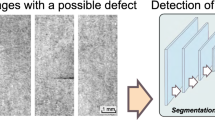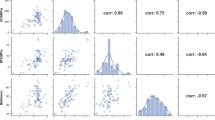Abstract
The porosity in manufactured components by additive manufacturing is a latent problem that leads to adverse effects on components such as fatigue. A correct segmentation and its subsequent classification allow us to identify its cause, either lack of fusion of particles or gases trapped during the process. There are several pores classifications described in the literature, but it is difficult to give a global classification. The present work describes a classification based on size, distribution, and origin of pores. For this purpose, the development of an artificial vision methodology is described that allows segmentation and classification of porosity with a high-accuracy rate in tracks manufactured by the laser metal deposition technique using commercial Al-5083 powders. The methodology is divided into 3 steps. (1) The first step consists of the image smoothing and denoising using a bilateral filtering. (2) A variant of the Hough transform has then implemented to segment the pores, and finally, (3) the automatic classification is performed by quadratic discriminant analysis (QDA) and Kohonen maps. The results obtained are compared with the manual classification of two materials experts. These results show an accuracy of + 95%. Our approach has the potential to be used in the analysis of any additively manufactured component.











Similar content being viewed by others
Change history
11 December 2019
Acknowledgments are due to program Cátedras-CONACYT (National Council for Science and Technology of Mexico) for the support provided by generating research opportunities through the projects num. 730 and num. 57.
11 December 2019
Acknowledgments are due to program C��tedras-CONACYT (National Council for Science and Technology of Mexico) for the support provided by generating research opportunities through the projects num. 730 and num. 57.
References
Baldevbhai PJ, Anand RS (2012) Color image segmentation for medical images using L* a* b* color space. IOSR J Electron Commun Eng 1(2):24–45
Bora DJ, Gupta AK (2014) A new approach towards clustering based color image segmentation. Int J Comput Appl, 107(12)
Brooks AJ, Ge J, Kirka MM, Dehoff RR, Bilheux HZ, Kardjilov N, Manke I, Butler LG (2017) Porosity detection in electron beam-melted Ti-6Al-4V using high-resolution neutron imaging and grating-based interferometry. Progress Additive Manuf 2(3):125–132
Cai X, Malcolm AA, Wong BS, Fan Zheng (2015) Measurement and characterization of porosity in aluminium selective laser melting parts using X-ray CT. Virtual Phys Prototyp 10(4):195–206
Cernadas E, Fernández-Delgado M, González-Rufino E, Carrión P (2017) Influence of normalization and color space to color texture classification. Pattern Recogn 61:120–138
Cunningham R, Narra SP, Montgomery C, Beuth J, Rollett AD (2017) Synchrotron-based X-ray microtomography characterization of the effect of processing variables on porosity formation in laser power-bed additive manufacturing of Ti-6Al-4V. Jom 69(3):479–484
Deshpande S, Kulkarni A, Sampath S, Herman H (2004) Application of image analysis for characterization of porosity in thermal spray coatings and correlation with small angle neutron scattering. Surf Coat Technol 187 (1):6–16
Dilip JJS, Zhang S, Teng C, Zeng K, Robinson C, Pal D, Stucker B (2017) Influence of processing parameters on the evolution of melt pool, porosity, and micro-structures in Ti-6Al-4V alloy parts fabricated by selective laser melting. Progress Additive Manuf 2(3):157–167
Fan K-C, Chen S-H, Chen J-Y, Liao W-B (2010) Development of auto defect classification system on porosity powder metallurgy products. NDT & E Int 43(6):451–460
Farzadi A, Solati-Hashjin M, Asadi-Eydivand M, Osman NAA (2014) Effect of layer thickness and printing orientation on mechanical properties and dimensional accuracy of 3D printed porous samples for bone tissue engineering. PloS one 9(9):e108252
Huang C, Wu Z, Huang R, Wang W, Li L (2017) Mechanical properties of AA5083 in different tempers at low temperatures. In: IOP conference series: materials science and engineering, vol 279. IOP Publishing, p 012002
Kahu SY, Raut RB, Bhurchandi KM Review and evaluation of color spaces for image/video compression. Color Research & Application
Kaneko K (1994) Determination of pore size and pore size distribution: 1. Adsorbents and catalysts. J Membrane Sci 96(1–2): 59–89
Khanzadeh M, Chowdhury S, Marufuzzaman M, Tschopp MA, Bian L (2018) Porosity prediction: supervised-learning of thermal history for direct laser deposition. J Manuf Syst 47:69–82
Kohonen T (2013) Essentials of the self-organizing map. Neural Netw 37:52–65
Lee YS, Nordin M, Babu SS, Farson DF (2014) Influence of fluid convection on weld pool formation in laser cladding. Weld J 93(8):292S–300S
Liu Y, Wang W, Xie J, Sun S, Wang L, Qian Y, Meng Y, Wei Y (2012) Microstructure and mechanical properties of aluminum 5083 weldments by gas tungsten arc and gas metal arc welding. Mater Sci Eng: A 549:7–13
Loizaga A, Sertucha J, Suarez R (2008) Defectos metalurgicos generados por la presencia de gases en el metal fundido. In: Anales de la Real Sociedad Espanola de Quimica, number 2. Real Sociedad Española de Química, pp 111–119
Lowell S, Shields JE, Thomas MA, Thommes M (2012) Characterization of porous solids and powders: surface area, pore size and density, vol 16. Springer Science & Business Media
Majnik M, Bosnić Z (2013) Roc analysis of classifiers in machine learning: a survey. Intell Data Anal 17 (3):531–558
Matrecano M (2012) Porous media characterization by micro-tomographic image processing. PhD thesis, PhD Thesis. Università di Napoli Federico II, Italy
Mays TJ (2007) A new classification of pore sizes. Stud Surf Sci Catal 160(Characterization of):57–62
Pang JHL, Kaminski J, Pepin H, et al. (2019) Characterisation of porosity, density, and microstructure of directed energy deposited stainless steel aisi 316l. Addit Manuf 25:286–296
Rong Weibin, Li Zhanjing, Zhang Wei, Sun Lining (2014) An improved canny edge detection algorithm. In: 2014 IEEE International Conference on Mechatronics and Automation (ICMA). IEEE, pp 577–582
Rouquerol J, Avnir D, Fairbridge CW, Everett DH, Haynes JM, Pernicone N, Ramsay JDF, Sing KSW, Unger KK (1994) Recommendations for the characterization of porous solids (technical report). Pure Appl Chem 66(8):1739–1758
Schlüter S, Sheppard A, Brown K, Wildenschild D (2014) Image processing of multiphase images obtained via x-ray microtomography: a review. Water Resour Res 50(4):3615–3639
Schwerdtfeger J, Singer RF, Körner C (2012) In situ flaw detection by IR-imaging during electron beam melting. Rapid Prototyp J 18(4):259–263
Qi S, Jia J, Agarwala A (2008) High-quality motion deblurring from a single image. In: ACM transactions on graphics (TOG), vol 27. ACM, p 73
Thompson A, Maskery I, Leach RK (2016) X-ray computed tomography for additive manufacturing: a review. Measur Sci Technol 27(7):072001
Vankawala F, Ganatra A, Patel A (2015) A survey on different image deblurring techniques. Int J Comput Appl 116:13
Wohlers T (2018) 3D printing and additive manufacturing state of the industry. Annual Worldwide Progress Report Wohlers Associates
Wu J-L, Chang C-F, Chen C-S (2013) An adaptive Richardson-Lucy algorithm for single image deblurring using local extrema filtering. J Appl Sci Eng 16(3):269–276
Yang H-L, Huang P-H, Lai S-H (2014) A novel gradient attenuation richardson–lucy algorithm for image motion deblurring. Signal Process 103:399–414
Yasa E, Kruth J-P, Deckers J (2011) Manufacturing by combining selective laser melting and selective laser erosion/laser re-melting. CIRP Annals 60(1):263–266
Zdravkov BD, Čermák JJ, Šefara M, Jankŭ J (2007) Pore classification in the characterization of porous materials: a perspective. Central Europ J Chem 5(2):385–395
Zhan X, Qi C, Gao Z, Tian D, Wang Z (2019) The influence of heat input on microstructure and porosity during laser cladding of invar alloy. Opt Laser Technol 113:453–461
Zhang B, Liu S, Shin YC (2019) In-process monitoring of porosity during laser additive manufacturing process. Additive Manufacturing
Zhang B, Ziegert J, Farahi F, Davies A (2016) In situ surface topography of laser powder bed fusion using fringe projection. Addit Manuf 12:100–107
Zhang B, Allebach JP (2008) Adaptive bilateral filter for sharpness enhancement and noise removal. IEEE Trans Image Process 17(5):664–678
Author information
Authors and Affiliations
Corresponding author
Additional information
Publisher’s note
Springer Nature remains neutral with regard to jurisdictional claims in published maps and institutional affiliations.
Rights and permissions
About this article
Cite this article
García-Moreno, AI. Automatic quantification of porosity using an intelligent classifier. Int J Adv Manuf Technol 105, 1883–1899 (2019). https://doi.org/10.1007/s00170-019-04067-5
Received:
Accepted:
Published:
Issue Date:
DOI: https://doi.org/10.1007/s00170-019-04067-5




